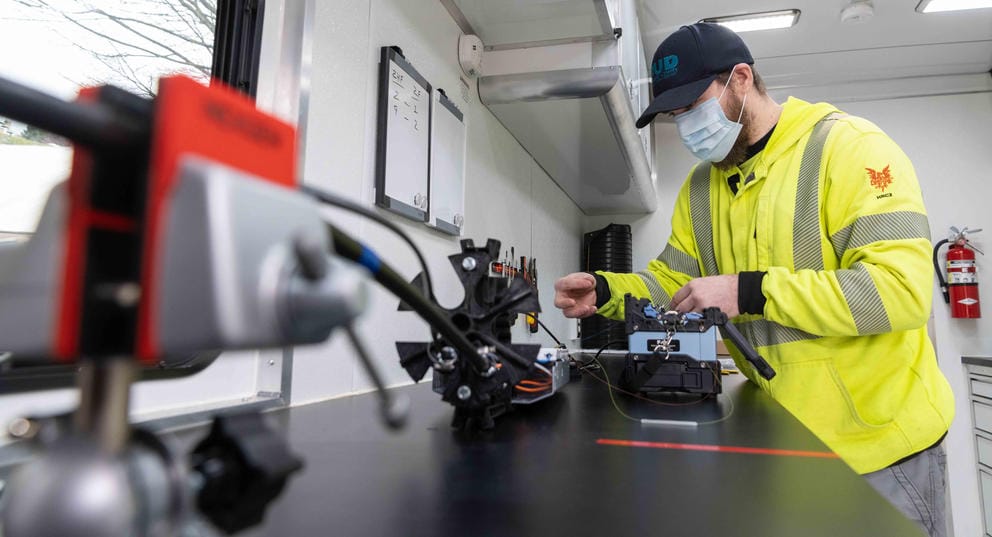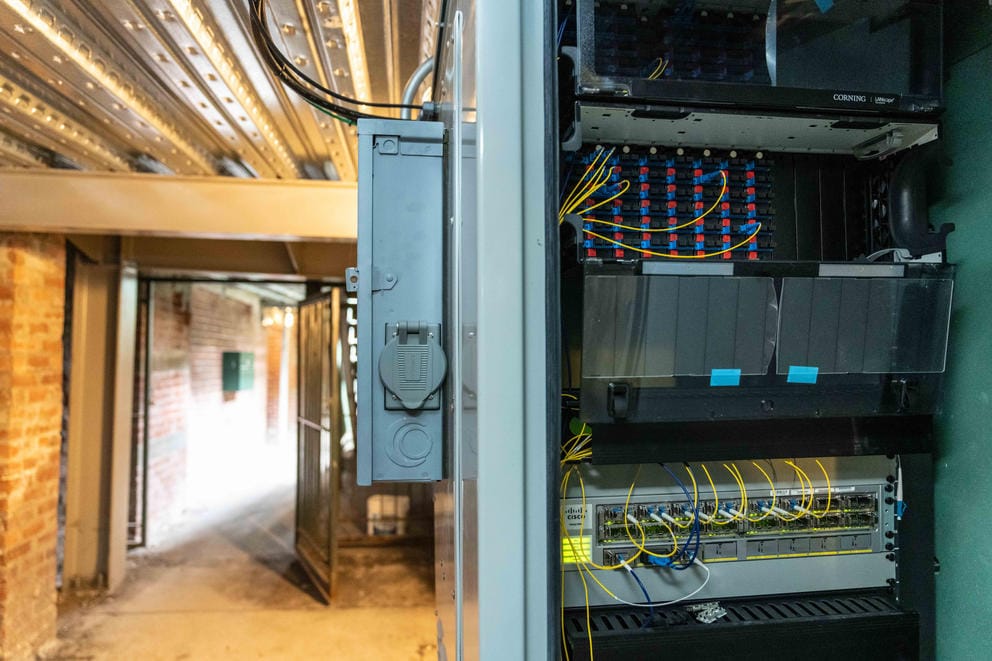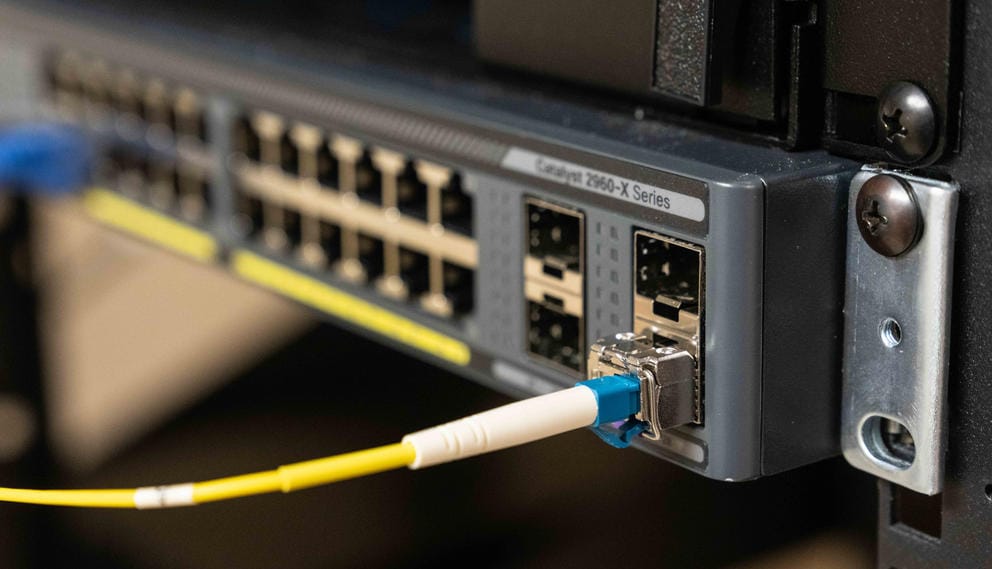If you want to know about the Olympic Peninsula’s internet problems, Brinnon — not so much a town as a handful of stores dotting Highway 101 — is a good place to start.
Ask Eloise Langenbach, who runs the Brinnon Food Bank, an organization that fills a huge role in a community where the nearest grocery store is 25 miles away.
Members of Langenbach’s all-volunteer staff work mostly from home, so they coordinate through Zoom meetings — but for some volunteers, the connection is so slow that logging in isn’t really an option.
“Some people can’t get through, so they have to just call in and listen to what’s going on, but they can’t really participate much,” Langebach said. “It’s iffy. Some days it works, others it doesn’t.”
Rural Jefferson County, which has just over 30,000 people and only one incorporated city (Port Townsend), is full of long stretches of road where you can barely see from one house to the next. Out here, broadband-speed internet service is sparse to nonexistent. Many of Langenbach’s volunteers rely on DSL — the 1990s web infrastructure that delivers slow connection through copper wires — which she described as “very, very sad.”
“You couldn’t stream anything,” Langenbach said of her attempts to connect to meetings with DSL through CenturyLink. Placing orders through Food Lifeline, a Seattle-based food bank supplier, was even harder.
“We’re not worth the effort, I guess, to put the money into [fiber] because there aren’t enough people,” Langenbach said.
Across Washington state, rural communities are competing for unprecedented amounts of federal grant dollars to bridge the digital divide. Most are choosing to partner with private telecommunications companies to hook up new customers. But taking advantage of a recent state law change, Jefferson County’s public utility district plans to be the first of Washington’s 28 PUDs to offer public retail broadband service.
“Residents begged us for better internet,” said Will O’Donnell, communications director of Jefferson’s PUD, which provides electricity to more than 19,000 of the county’s homes, as well as water and septic to 5,000 homes, and has a budget nearly the size of the city of Port Townsend’s.
Earlier this year, Jefferson’s PUD won more than $24 million in grants to connect 2,600 homes in the communities of Quilcene, Discovery Bay, Gardiner, Cape George and Marrowstone Island. Construction is set to begin later this year, with the first customers getting hooked up sometime in 2023. They will likely pay about $65 per month for speeds of 100 megabits per second, with superfast gigabit speeds available for $90 per month (and a $20 discount for low-income customers).

David Elias, supervisory controls and data acquisition technician at the Jefferson County Public Utility District, splices fiber optic strands, March 11, 2022, in Port Townsend. Jefferson County PUD will become an internet provider in an effort bring broadband to residents. (Stephen Brashear for Crosscut)
Washington’s broadband push
Brinnon is not the only rural community that major internet companies have left in the dark. In a survey of some 32,000 web users conducted by Washington’s State Broadband Office, about 64% of households reported download speeds of below 25 megabits per second — the minimum the Federal Communication Commission considers broadband. (Many experts consider that bar too low, and just a few weeks ago, Washington state raised its “broadband” definition to a minimum of 100 megabits per second.)
After creating the state broadband office in 2019, Washington has ramped up its efforts to connect unserved communities, earmarking $411 million of mostly federal dollars for new fiber networks that could connect up to 35,000 Washington households — which is still just a fraction of those who lack access. Most of that money comes from the Coronavirus State Fiscal Recovery Fund, which consists of flexible federal dollars given to states through the American Rescue Plan Act.
This story is a part of Crosscut’s WA Recovery Watch, an investigative project tracking federal dollars in Washington state.
On a recent Friday morning in downtown Port Townsend, PUD employee David Elias ran a fiber line from the back of a van, into a nearby utility pole, and across the street to a frame store/photography studio. Over the past two decades, the PUD built out a fiber network in Port Townsend that now connects about 50 businesses — although until 2021, state law made it illegal to serve them the internet directly, so customers depended on a private provider to lease the fiber and resell it to them.
“In this case, we own the network, we’re building the network, but prior to summer of 2021, we weren’t allowed to do that last step of doing the billing and final maintenance,” O’Donnell said.

Jefferson County PUD’s David Elias splices fiber optic strands, March 11, 2022 in Port Townsend. The PUD will become an internet provider in an effort bring broadband to residents. (Stephen Brashear for Crosscut)
Until 2021, Washington was one of 20 states that banned or restricted public agencies from selling internet service. That changed with the passage of two bills in May 2021. Although it’s legal now, O’Donnell says hooking up businesses directly in places like Port Townsend is a lower priority than rural residential areas that are completely unserved.
“We’re taking that extra step to be that retail ISP so we can capture all of the revenue,” he said, “and also so that, in our rural areas, we can ensure our customers that if we build it, there will be someone there to provide that service and take care of that service in case anything goes wrong.”
Across the country, there are at least 40 community-owned broadband networks that bring fiber to the home, according to a 2018 Harvard University study, which also found that such networks tend to be cheaper and more transparent about pricing.
The city of Anacortes recently launched a public internet system that directly connects customers, but Jefferson would be the first county PUD in Washington to do so.

A fiber optic central office is pictured in a tunnel, March 11, 2022 in Port Townsend. (Stephen Brashear for Crosscut)
Ports vs. PUDs
In addition to public utility districts, many of Washington’s local ports have historically led public broadband efforts.
In 2000, the state Legislature allowed ports and PUDs to start building fiber infrastructure — but only for “wholesale” use, meaning they must lease it out to private companies that would then resell it to end users. More than a dozen PUDs and at least six ports across the state now operate “wholesale” networks.
To apply for a broadband grant through the state Department of Commerce, a port or utility district must identify an internet service provider. Many of these are private companies, often simply the largest existing provider in the area. The company scooping up the most contracts so far has been Ziply Fiber, a rebranding of the Northwest operations of Frontier, which was acquired for $1.35 billion in 2020 by WaveDivision and is partnering with the Ports of Skagit and Whitman, as well as Snohomish County.
Under a $1.3 million agreement signed with the Port of Whitman County in March 2021, Ziply will own the infrastructure but the port will retain an “irrevocable right to use” it for 20 years, which will allow other internet service providers to offer service over the system. According to Calvin Johanson, the Port of Whitman County’s special projects administrator, at least one other internet provider has signed up to offer service in each of the five towns where Ziply has completed the publicly funded buildout.
Johanson described the Ziply partnership as a good deal for the port. Ziply already had plans to expand in Whitman County before it won a $1 million state broadband grant, he said, and because it already owns some infrastructure and has the expertise, it can build the system faster and for less money.
Unlike public utility districts, which maintain sewer systems and serve customers with electricity, ports’ primary function is business development — so the idea of operating a broadband network themselves rarely comes into play.
“To go to retail is a complete different game,” said Joe Poire, manager of Petrichor Broadband, a group of six port districts that helps ports apply for broadband grants. Poire formerly ran the Port of Whitman County, which helped advocate for the law change and built more than 300 miles of so-called “dark” fiber in the past two decades.
The biggest difference between ports and public utility districts, Poire said, is that ports look at broadband like an airport or an industrial park — they build the foundation, and businesses come in and use it.
By contrast, public utility districts may already provide electricity, employ maintenance technicians, bill customers and handle service complaints.
“I mean, they’re already three-quarters of the way there,” Poire said. “We’re not even there in concept.”

A fiber optic cable and a switch are pictured on Friday, March 11, 2022 in Port Townsend. (Stephen Brashear for Crosscut)
Challenges of being first
Not every PUD is eager to jump into the retail market, even those that already operate robust wholesale fiber networks. Karen Affeld, who helped convene broadband action teams in Clallam and Jefferson counties as the executive director of the North Olympic Development Council, said there’s some trepidation about being first.
“In some cases they feel like broadband is not part of their core mission, that their core mission is providing electricity and or water, and broadband is something different or extra. So making a big investment in that feels like it is a disservice to their rate payers,” Affeld said. “And then I think others just didn’t want to be the first one to try it. They want to see somebody do it, see how it works, see if they make money, see if they lose money.”
In Jefferson County’s case, the PUD has for years been studying what it would cost to bring its own broadband network online — but concluded it would be financially feasible only if the upfront construction was paid for by a grant. There are other costs, too: ongoing maintenance and new technicians, engineers and accountants to hire. Even with the federal money, they expect it will take five years after they reach a certain customer level to break even.

Jefferson County Commissioner Greg Brotherton poses for a picture in front of his home, March 11, 2022, near Quilcene. Like many residents in the county, Brotherton has struggled to find affordable broadband solutions. (Stephen Brashear for Crosscut)
“We have over 400 miles of road in Jefferson County and often a quarter mile between properties. There isn’t an incentive for private businesses to really expand past the population centers,” said Greg Brotherton, who lives out on Leland Lake, a 6-mile drive north of Quilcene.
Throughout the pandemic, Brotherton’s video stream lagged and he got booted from Zoom meetings, which would be a minor irritation, but is especially problematic for him — because he’s one of Jefferson County’s three commissioners.
“We work under the public meetings act, so if you lose access to a meeting, you have to stop the meeting,” Brotherton said. “Even when the service works, it reduces my ability to communicate with my peers and to do the work online.”
There’s a lot of details still to be worked out on Jefferson County’s pioneering broadband push, including how many people ultimately sign up. Based on survey responses and the dearth of other options, the county is expecting a “take rate” between 60% and 70%, said O’Donnell, the county's communication director.
It’s also an open question whether any private internet providers will emerge and offer service on the new networks once they’re built. The system will be open access, but O’Donnell said he hasn’t heard anything from Wave or CenturyLink, the two biggest providers in the area, that would indicate they want to offer service when the new fiber lines roll out.
“CenturyLink has no plans to expand here,” O’Donnell said. “Without us taking action, we don’t see that there’s going to be anyone else.”
Clarification: Jefferson County PUD does not plan to build out broadband to Brinnon. But a separate effort led by a Mason County company recently won a federal grant to build a fiber network extending into Brinnon.



